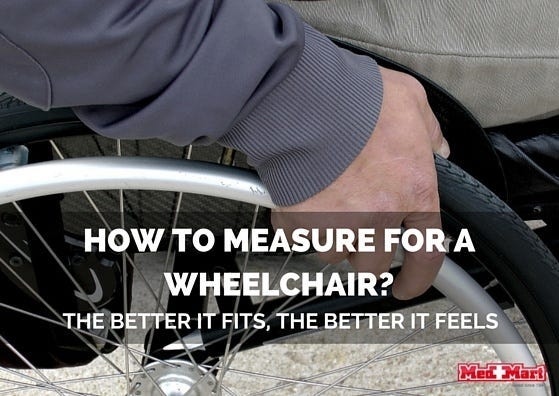
Post Contents [hide]
Did you know that wheelchairs come in different sizes? As you look at the many wheelchairs available, you’ll find that they have different measurements in terms of height and seat dimensions.
It’s important that your wheelchair fits you well. A good fit will be comfortable, provide the right amount of support, and be easy to operate. On the other hand, a poorly fitting wheelchair may leave you uncomfortable, increase the chance of you sliding down in the chair, and be difficult to use and maneuver.
Before you buy a wheelchair, get measured to ensure a great fit. Here’s how to measure for a wheelchair.
#1 Seat Size


Start by measuring yourself for the proper seat size. While seated, have a helper measure the width of the largest part of your hips, thighs, or buttocks. Then, add two inches to this measurement – the total measurement is the width that you will need in a wheelchair seat.
Next, determine the depth of a seat that you will need. While seated, have a helper measure from the back of your buttock to the interior fold just behind your knee. Subtract two inches from this measurement to determine the depth of the seat that you will need.
#2 Wheelchair Back Height


The back height that you will need in a wheelchair partially depends on your upper body strength and your personal preferences. At a minimum, you want the wheelchair’s back to reach up to your mid-back. A higher back which reaches up to your shoulders provides more support. To determine the height that you need in the wheelchair back, have a helper measure you while you’re seated. They should measure from where your seat meets the chair, straight up to the point of your back where you want the chair’s back to stop.
#3 Wheelchair Seat Height


The overall height of the wheelchair’s seat contributes to functionality and practicality during your daily use of the chair. If you plan to power the wheelchair with your feet, then the height of the chair probably needs to be a little lower than the height you would generally use.
While sitting with your knees at a 90-degree angle, have a helper measure from your heel straight up to the fold at the back of your knee. Add two inches to this measurement; this is your minimum seat height (you may prefer to go higher). If your wheelchair includes a thick cushion, the cushion’s dimensions are not included in the seat height provided by the manufacturer. So, if you’re using a cushion which is 2” thick when you’re sitting on it, then you will want to subtract these 2” from your seat height measurement to get your true measurement for this particular wheelchair.
#4 Getting Through Doorways
Getting through doorways and passages with a wheelchair poses a unique set of challenges, especially when confronted with the narrowness and obstacles typical of many environments. Achieving optimal accessibility requires a careful balance between the width of the wheelchair and the maneuverability it allows.
Wide wheelchairs offer stability and comfort but may struggle in tight spaces, while narrower models enhance the ease of passage through narrow doorways, improving accessibility. Addressing these issues is crucial for ensuring that individuals can move freely and confidently, without the fear of being hindered by the physical constraints of their surroundings.
With these basic measurements, you should be able to find a wheelchair which fits you well. If a wheelchair just doesn’t feel right, then try another style – different model wheelchairs fit differently, so you’re sure to find a wheelchair which is just perfect for you. If you are in need of a fast moving wheelchair check out this article… What Is the Best Wheelchair for Easy Transportation? Also make sure to check out Med Mart's compact scooters for elderly and most comfortable hospital beds.
FAQS
How wide should a wheelchair be?
A wheelchair should be wide enough to comfortably fit the user. For a proper fit, typically add 2 inches to the width of the user's hips.
How do you measure wheelchair width?
To measure wheelchair width, measure the widest part of the user's hips or thighs and add 2 inches to ensure comfort and ease of movement.
How does wheelchair width affect maneuverability?
Wheelchair width affects maneuverability; wider wheelchairs may be more challenging to navigate through narrow doorways and tight spaces.
How to choose the correct wheelchair width for a person?
Measure the user's hip width, consider daily activities, and add 2 inches for comfort and clothing to choose the right wheelchair width.
How wide are standard wheelchairs?
Standard wheelchairs are typically 24 to 27 inches wide and designed to pass through standard doorways, which are usually 32 inches wide.
How does wheelchair width impact door accessibility?
Wheelchair width impacts door accessibility; wheelchairs must be narrow enough to fit through the standard door width of 32 inches comfortably.